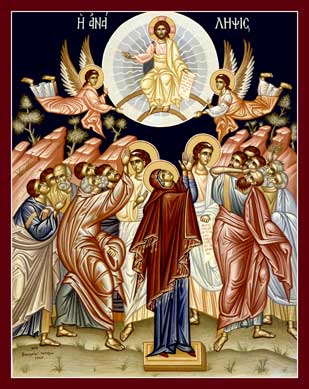 Icon of the Ascension of Christ
Icon of the Ascension of Christ
Design
The icon is divided into two parts, top and bottom, heaven and earth. The top is in order, the bottom, except for the Theotokos, is in confusion. The figures are set against the hilly landscape of the Mount of Olives, scattered with olive trees. It is painted with bright colors as a joyous icon.
Theology
Although the icon depicts the event described by Saint Luke, it is not meant to be a historical picture, but a representation of the Church.
Christ
Christ is shown inside the mandorla blessing all with his right hand and holding a scroll in his left. This is to show love and knowledge. This sphere is being carried up in glory by angels.
Even though we see Christ departing, the Orthodox Church sees the second and glorious coming in the same icon. Jesus said he would return exactly as he ascended. The icon does not show direction. Though Christ has ascended, He has said, “I will never leave you nor forsake you.” (Hebrews 13:5)
The Theotokos
The focus of the lower part of the icon is the Theotokos. She represents the entire Church waiting for Jesus’ return.
The disciples
The entire group, the Theotokos and the disciples also represent the Church. In this case the faithful learning Christians. The disciples are waiting for the descent of the Holy Spirit at Pentecost and are shown in confusion.
The disciples shown can not be the historical gathering, but again a image of the Church. The Apostle Paul who was still Saul, a nonbeliever at that time, is standing next to Mary.
Angels
Then two angels in white clothes said to the disciples, “Men of Galilee, why do you stand looking into heaven? This Jesus, who was taken up from you into heaven, will come in the same way as you saw him go into heaven.” Then the disciples returned to Jerusalem (Acts 1:11).
